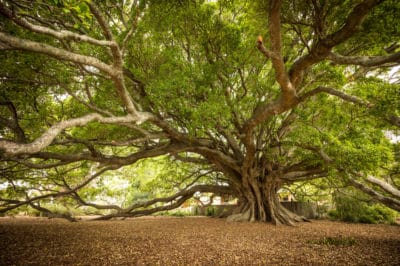About the Fig
Fig trees are mostly native to the Mediterranean. The fig has a long history in the garden and orchard – archeological evidence indicates humans have been probably growing figs for 9,000 years. In the wild, some kinds of figs grow in other trees and can literally take over and strangle their hosts. Many figs produce fruit, but not all are eaten by humans.
Kinds of Figs
More than 800 different kinds of figs have been identified. Many have unique characteristics. Different kinds of figs include:
- Ficus carica – common edible fig
- Ficus benjamina – weeping fig
- Ficus pumila – creeping fig
- Ficus scobina – sandpaper fig
- Ficus lyrata – fiddle-leaf fig
- Ficus aurea – Florida strangler fig.
Flowers and Fruit
Most figs produce a fruit with an easily recognizable shape – a broad-based teardrop – although a few are more round. However, you might not know that this fruit is actually an inverted flower called a synconium, with the flowers enclosed inside. The flowers of many varieties must be pollinated by tine wasps that crawl inside. When you eat a fig, you are actually eating flowers, seeds and stem tissue.
Leaf Shape
Fig leaves come in five basic shapes. The common fig has an easily recognizable, broad, palmate leaf that looks like a hand. Other figs have oval or elliptical smooth-edged leaves. Undulate leaves are also oval but have irregular edges. Cordate leaves are heart-shaped. Truncate leaves have a straight base that is perpendicular to the leaf. Decurrent leaves extend downward along the stem.
Unique Figs
Some figs are easily recognizable because of their appearance. Strangler figs are hemi-epiphytic – they grow in the upper levels of trees like orchids. As the fig matures, it sends roots down to ground. The roots twine around the supporting tree trunk and over time can kill the host tree. Sandpaper figs have a rough leaf surface. The Great Banyan, in India, is a single tree that occupies over four acres.
Figs That Aren’t Trees
Ornamental figs like the fiddle-leaf fig aren’t really trees – they are large shrubs. They may have single or multiple trunks. They are easily recognizable by their leaves, which resemble a fiddle or violin. The creeping fig is actually a woody evergreen vine with tendrils that can take root or damage structures. It is often used as a houseplant.
